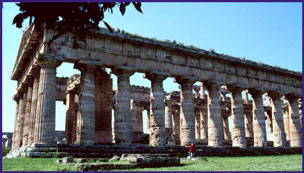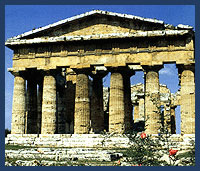





















 |
 Paestum
has always been shrouded in mystery. It was probably founded around 650 BC by a
large group of Dorians who had been expelled from the city of Sybaris, a
luxurious resort across the mainland on the Ionian Sea. The Dorians named their
new colony Poseidonia, after the most important of their gods; it flourished and
quickly became the greatest city on the gulf of Salerno. Then in 510 BC, Sybaris
was destroyed. Poseidonia languished until 390 BC, when it fell to a tribe of
local barbarians called the Lucanians. Legend has it that for decades the Greek
inhabitants of the captive city secretly met once a year to remember the
illustrious days of their forefathers. Paestum
has always been shrouded in mystery. It was probably founded around 650 BC by a
large group of Dorians who had been expelled from the city of Sybaris, a
luxurious resort across the mainland on the Ionian Sea. The Dorians named their
new colony Poseidonia, after the most important of their gods; it flourished and
quickly became the greatest city on the gulf of Salerno. Then in 510 BC, Sybaris
was destroyed. Poseidonia languished until 390 BC, when it fell to a tribe of
local barbarians called the Lucanians. Legend has it that for decades the Greek
inhabitants of the captive city secretly met once a year to remember the
illustrious days of their forefathers.
In
273 BC, the Romans arrived. They changed the city's name, but we know as little
about Roman Paestum as we do about its Greek predecessor. Entire centuries passed in obscurity, briefly
interrupted by moments of glory: in the early 3rd century BC, Paestum was
heralded as a loyal ally of Rome against Hannibal; in 79 BC, the eruption of
Vesuvius partially destroyed it. Perhaps it was volcanic ash that helped to silt
up the mouth of the river on which the city stood; this led the surrounding
countryside to become swampy and mosquito-ridden. Christianity arrived,
eventually bringing a bishop and at least two churches. In the 9th century AD,
nearby Agropolis was taken over by Saracens. These Muslim Arabs introduced such
delicacies as pasta and buffalo (source of the exquisite mozzarella di bufala),
but they were also such fierce fighters that they soon became as dreaded as the
malarial mosquitos.
about its Greek predecessor. Entire centuries passed in obscurity, briefly
interrupted by moments of glory: in the early 3rd century BC, Paestum was
heralded as a loyal ally of Rome against Hannibal; in 79 BC, the eruption of
Vesuvius partially destroyed it. Perhaps it was volcanic ash that helped to silt
up the mouth of the river on which the city stood; this led the surrounding
countryside to become swampy and mosquito-ridden. Christianity arrived,
eventually bringing a bishop and at least two churches. In the 9th century AD,
nearby Agropolis was taken over by Saracens. These Muslim Arabs introduced such
delicacies as pasta and buffalo (source of the exquisite mozzarella di bufala),
but they were also such fierce fighters that they soon became as dreaded as the
malarial mosquitos.  By
877 AD, the inhabitants of Paestum had abandoned the city and retreated to the
safety of the nearby hills. By
877 AD, the inhabitants of Paestum had abandoned the city and retreated to the
safety of the nearby hills.
Incredibly,
although Paestum's Temple of Hera (also called "of Poseidon") was
among the most famous cult-worship sites in antiquity, and although it is the
oldest, best preserved and most beautiful Doric temple in existence today, and
despite the city's proximity to Salerno (24 miles) and Capaccio (4 miles), these
majestic ruins were unknown all through the Middle Ages and the Renaissance.
Indeed, although scholars had been searching for them for centuries, they were
not discovered until 1740 and even then, not accurately described until 1779.
|
